Entrepreneurship Report: Theory, Practice, and Case Study Analysis
VerifiedAdded on 2022/12/28
|9
|2474
|77
Report
AI Summary
This report provides a comprehensive analysis of entrepreneurship, exploring its theoretical foundations and practical applications. It begins with an introduction to the concept of entrepreneurship, followed by a detailed discussion of its various conceptualizations, including definitions, positive and negative aspects, and key entrepreneurial attributes and traits. The report then delves into two case studies: the entrepreneurial journey of Aristoteles Onassis, examining his business strategies and traits; and the story of Mark Zuckerberg, analyzing his approach to building Facebook and his entrepreneurial style. The analysis focuses on whether 'you can make an omelette without breaking eggs,' evaluating if difficult behavior or shady dealings are acceptable trade-offs for success. The report concludes by synthesizing the insights from the case studies and providing a final answer to the central question, supported by the analysis of the two entrepreneurs. The report utilizes at least 10 academic sources, showcasing a thorough understanding of the subject matter.
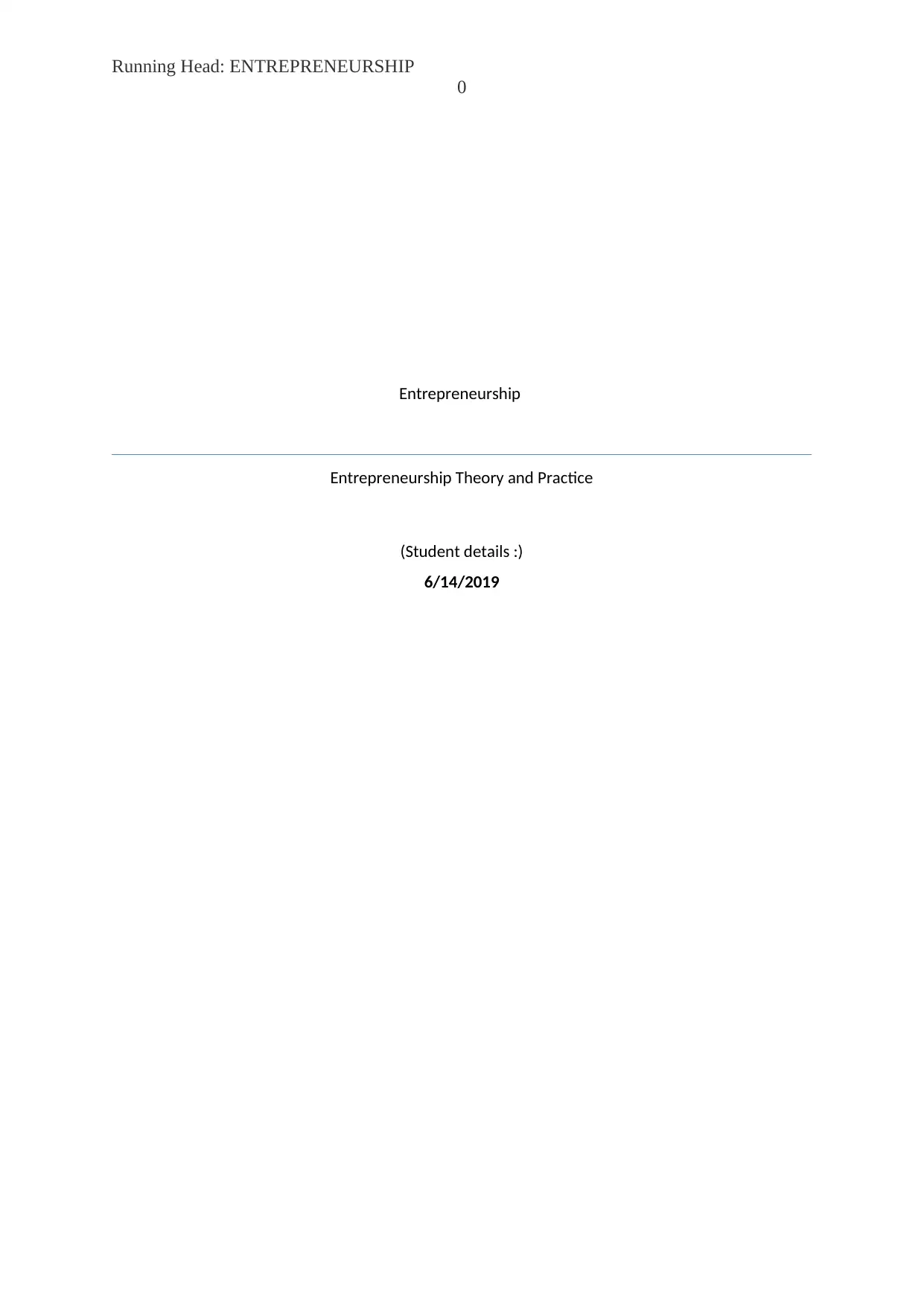
Running Head: ENTREPRENEURSHIP
0
Entrepreneurship
Entrepreneurship Theory and Practice
(Student details :)
6/14/2019
0
Entrepreneurship
Entrepreneurship Theory and Practice
(Student details :)
6/14/2019
Paraphrase This Document
Need a fresh take? Get an instant paraphrase of this document with our AI Paraphraser
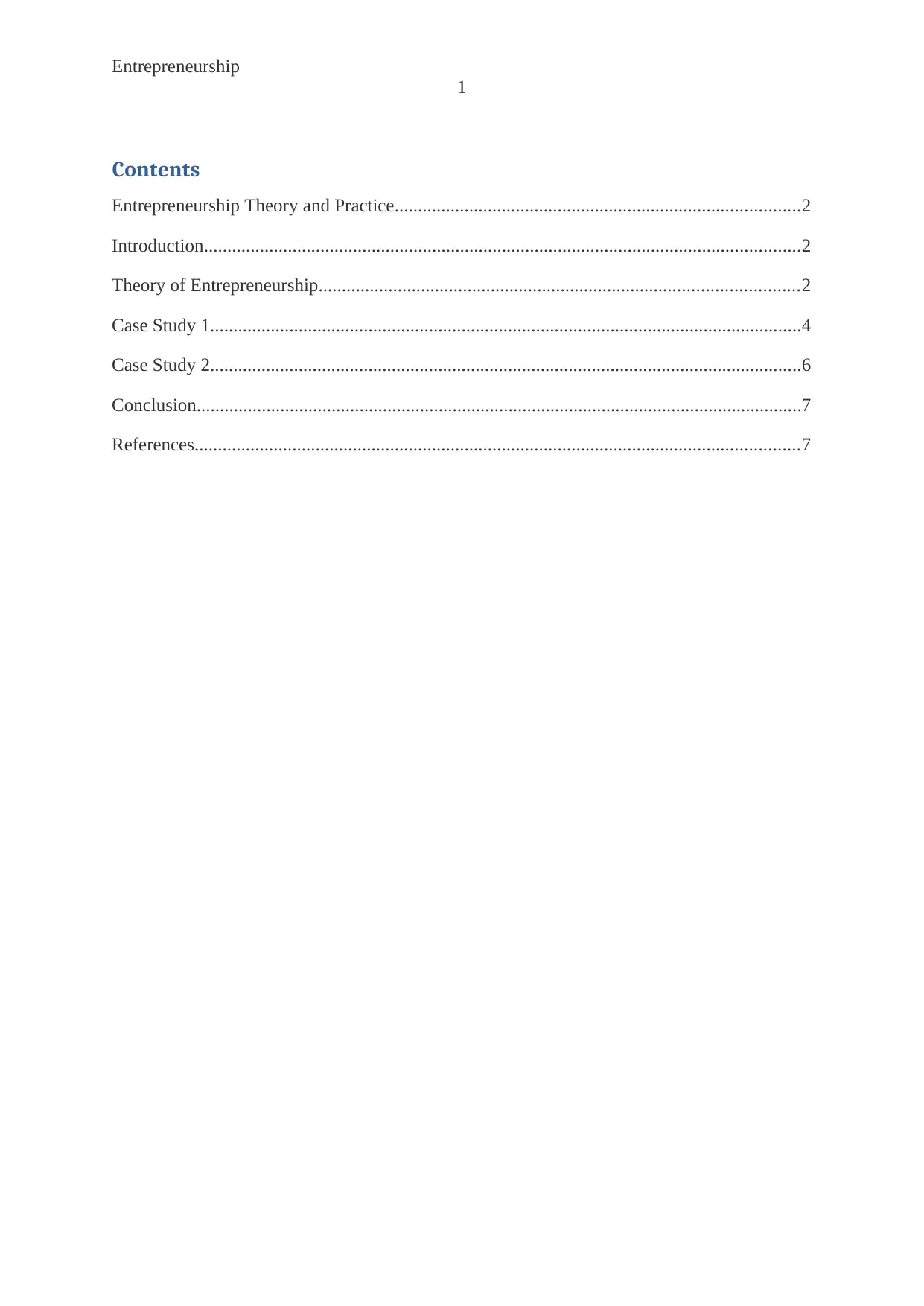
Entrepreneurship
1
Contents
Entrepreneurship Theory and Practice.......................................................................................2
Introduction................................................................................................................................2
Theory of Entrepreneurship.......................................................................................................2
Case Study 1...............................................................................................................................4
Case Study 2...............................................................................................................................6
Conclusion..................................................................................................................................7
References..................................................................................................................................7
1
Contents
Entrepreneurship Theory and Practice.......................................................................................2
Introduction................................................................................................................................2
Theory of Entrepreneurship.......................................................................................................2
Case Study 1...............................................................................................................................4
Case Study 2...............................................................................................................................6
Conclusion..................................................................................................................................7
References..................................................................................................................................7
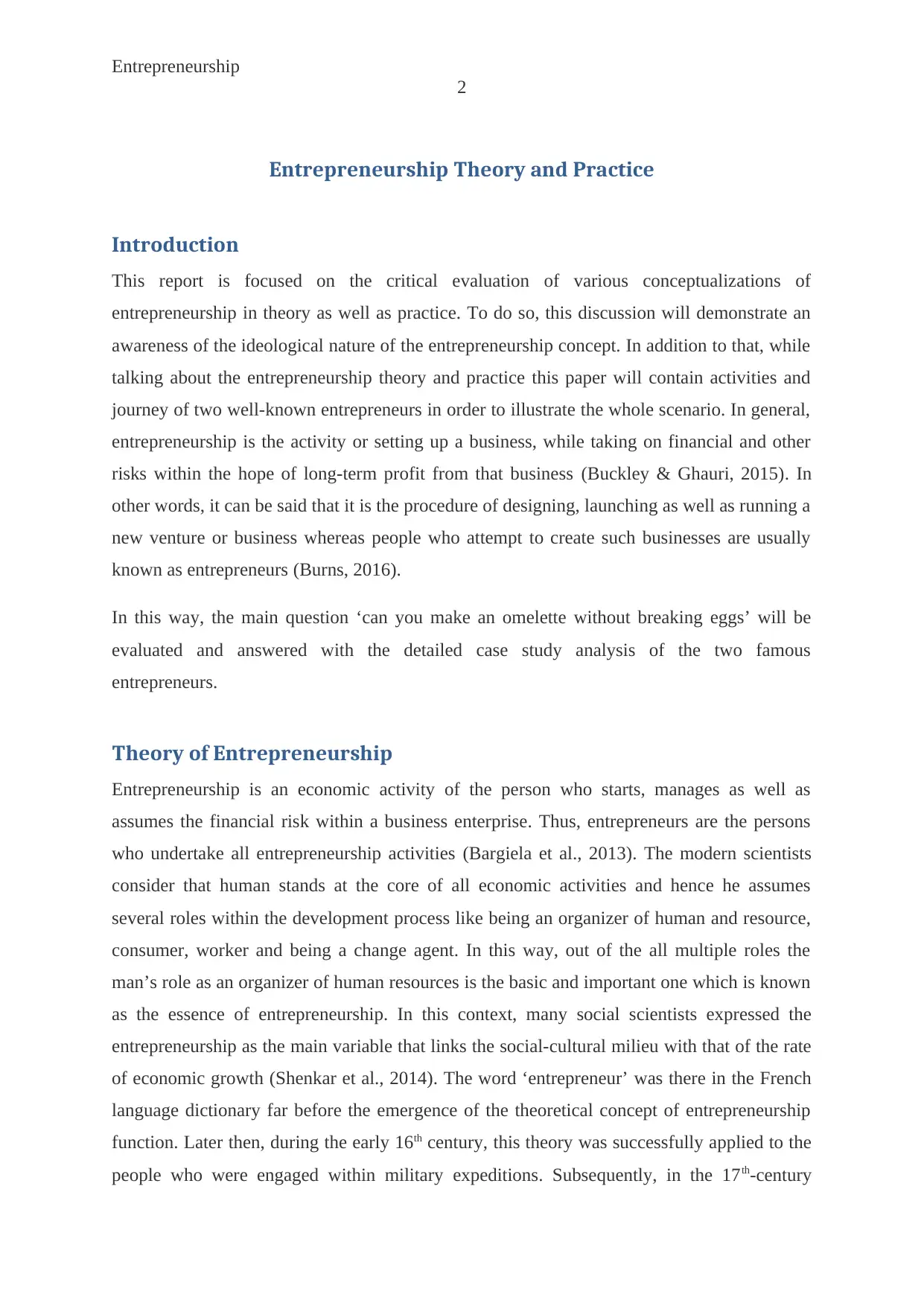
Entrepreneurship
2
Entrepreneurship Theory and Practice
Introduction
This report is focused on the critical evaluation of various conceptualizations of
entrepreneurship in theory as well as practice. To do so, this discussion will demonstrate an
awareness of the ideological nature of the entrepreneurship concept. In addition to that, while
talking about the entrepreneurship theory and practice this paper will contain activities and
journey of two well-known entrepreneurs in order to illustrate the whole scenario. In general,
entrepreneurship is the activity or setting up a business, while taking on financial and other
risks within the hope of long-term profit from that business (Buckley & Ghauri, 2015). In
other words, it can be said that it is the procedure of designing, launching as well as running a
new venture or business whereas people who attempt to create such businesses are usually
known as entrepreneurs (Burns, 2016).
In this way, the main question ‘can you make an omelette without breaking eggs’ will be
evaluated and answered with the detailed case study analysis of the two famous
entrepreneurs.
Theory of Entrepreneurship
Entrepreneurship is an economic activity of the person who starts, manages as well as
assumes the financial risk within a business enterprise. Thus, entrepreneurs are the persons
who undertake all entrepreneurship activities (Bargiela et al., 2013). The modern scientists
consider that human stands at the core of all economic activities and hence he assumes
several roles within the development process like being an organizer of human and resource,
consumer, worker and being a change agent. In this way, out of the all multiple roles the
man’s role as an organizer of human resources is the basic and important one which is known
as the essence of entrepreneurship. In this context, many social scientists expressed the
entrepreneurship as the main variable that links the social-cultural milieu with that of the rate
of economic growth (Shenkar et al., 2014). The word ‘entrepreneur’ was there in the French
language dictionary far before the emergence of the theoretical concept of entrepreneurship
function. Later then, during the early 16th century, this theory was successfully applied to the
people who were engaged within military expeditions. Subsequently, in the 17th-century
2
Entrepreneurship Theory and Practice
Introduction
This report is focused on the critical evaluation of various conceptualizations of
entrepreneurship in theory as well as practice. To do so, this discussion will demonstrate an
awareness of the ideological nature of the entrepreneurship concept. In addition to that, while
talking about the entrepreneurship theory and practice this paper will contain activities and
journey of two well-known entrepreneurs in order to illustrate the whole scenario. In general,
entrepreneurship is the activity or setting up a business, while taking on financial and other
risks within the hope of long-term profit from that business (Buckley & Ghauri, 2015). In
other words, it can be said that it is the procedure of designing, launching as well as running a
new venture or business whereas people who attempt to create such businesses are usually
known as entrepreneurs (Burns, 2016).
In this way, the main question ‘can you make an omelette without breaking eggs’ will be
evaluated and answered with the detailed case study analysis of the two famous
entrepreneurs.
Theory of Entrepreneurship
Entrepreneurship is an economic activity of the person who starts, manages as well as
assumes the financial risk within a business enterprise. Thus, entrepreneurs are the persons
who undertake all entrepreneurship activities (Bargiela et al., 2013). The modern scientists
consider that human stands at the core of all economic activities and hence he assumes
several roles within the development process like being an organizer of human and resource,
consumer, worker and being a change agent. In this way, out of the all multiple roles the
man’s role as an organizer of human resources is the basic and important one which is known
as the essence of entrepreneurship. In this context, many social scientists expressed the
entrepreneurship as the main variable that links the social-cultural milieu with that of the rate
of economic growth (Shenkar et al., 2014). The word ‘entrepreneur’ was there in the French
language dictionary far before the emergence of the theoretical concept of entrepreneurship
function. Later then, during the early 16th century, this theory was successfully applied to the
people who were engaged within military expeditions. Subsequently, in the 17th-century
⊘ This is a preview!⊘
Do you want full access?
Subscribe today to unlock all pages.

Trusted by 1+ million students worldwide
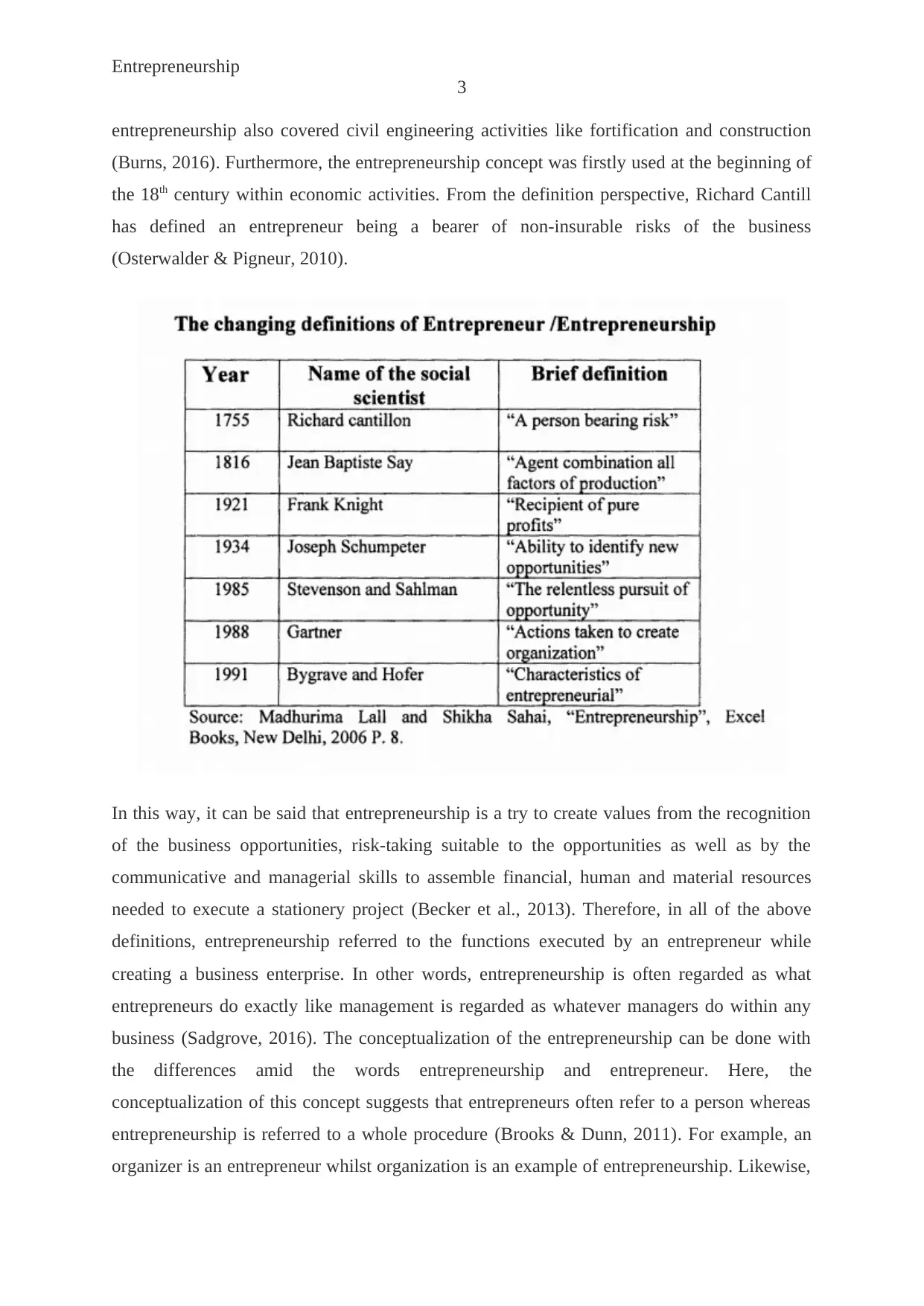
Entrepreneurship
3
entrepreneurship also covered civil engineering activities like fortification and construction
(Burns, 2016). Furthermore, the entrepreneurship concept was firstly used at the beginning of
the 18th century within economic activities. From the definition perspective, Richard Cantill
has defined an entrepreneur being a bearer of non-insurable risks of the business
(Osterwalder & Pigneur, 2010).
In this way, it can be said that entrepreneurship is a try to create values from the recognition
of the business opportunities, risk-taking suitable to the opportunities as well as by the
communicative and managerial skills to assemble financial, human and material resources
needed to execute a stationery project (Becker et al., 2013). Therefore, in all of the above
definitions, entrepreneurship referred to the functions executed by an entrepreneur while
creating a business enterprise. In other words, entrepreneurship is often regarded as what
entrepreneurs do exactly like management is regarded as whatever managers do within any
business (Sadgrove, 2016). The conceptualization of the entrepreneurship can be done with
the differences amid the words entrepreneurship and entrepreneur. Here, the
conceptualization of this concept suggests that entrepreneurs often refer to a person whereas
entrepreneurship is referred to a whole procedure (Brooks & Dunn, 2011). For example, an
organizer is an entrepreneur whilst organization is an example of entrepreneurship. Likewise,
3
entrepreneurship also covered civil engineering activities like fortification and construction
(Burns, 2016). Furthermore, the entrepreneurship concept was firstly used at the beginning of
the 18th century within economic activities. From the definition perspective, Richard Cantill
has defined an entrepreneur being a bearer of non-insurable risks of the business
(Osterwalder & Pigneur, 2010).
In this way, it can be said that entrepreneurship is a try to create values from the recognition
of the business opportunities, risk-taking suitable to the opportunities as well as by the
communicative and managerial skills to assemble financial, human and material resources
needed to execute a stationery project (Becker et al., 2013). Therefore, in all of the above
definitions, entrepreneurship referred to the functions executed by an entrepreneur while
creating a business enterprise. In other words, entrepreneurship is often regarded as what
entrepreneurs do exactly like management is regarded as whatever managers do within any
business (Sadgrove, 2016). The conceptualization of the entrepreneurship can be done with
the differences amid the words entrepreneurship and entrepreneur. Here, the
conceptualization of this concept suggests that entrepreneurs often refer to a person whereas
entrepreneurship is referred to a whole procedure (Brooks & Dunn, 2011). For example, an
organizer is an entrepreneur whilst organization is an example of entrepreneurship. Likewise,
Paraphrase This Document
Need a fresh take? Get an instant paraphrase of this document with our AI Paraphraser
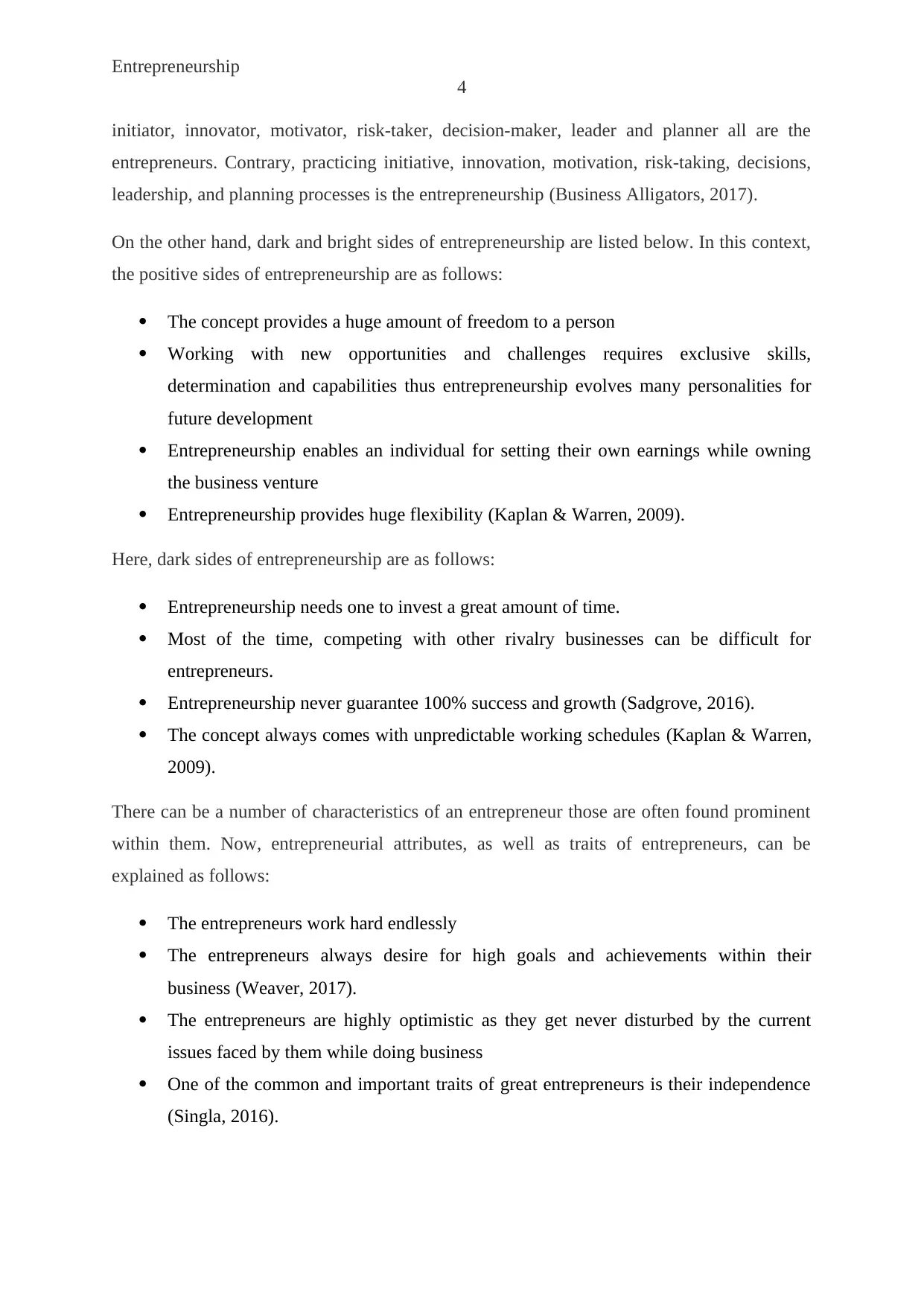
Entrepreneurship
4
initiator, innovator, motivator, risk-taker, decision-maker, leader and planner all are the
entrepreneurs. Contrary, practicing initiative, innovation, motivation, risk-taking, decisions,
leadership, and planning processes is the entrepreneurship (Business Alligators, 2017).
On the other hand, dark and bright sides of entrepreneurship are listed below. In this context,
the positive sides of entrepreneurship are as follows:
The concept provides a huge amount of freedom to a person
Working with new opportunities and challenges requires exclusive skills,
determination and capabilities thus entrepreneurship evolves many personalities for
future development
Entrepreneurship enables an individual for setting their own earnings while owning
the business venture
Entrepreneurship provides huge flexibility (Kaplan & Warren, 2009).
Here, dark sides of entrepreneurship are as follows:
Entrepreneurship needs one to invest a great amount of time.
Most of the time, competing with other rivalry businesses can be difficult for
entrepreneurs.
Entrepreneurship never guarantee 100% success and growth (Sadgrove, 2016).
The concept always comes with unpredictable working schedules (Kaplan & Warren,
2009).
There can be a number of characteristics of an entrepreneur those are often found prominent
within them. Now, entrepreneurial attributes, as well as traits of entrepreneurs, can be
explained as follows:
The entrepreneurs work hard endlessly
The entrepreneurs always desire for high goals and achievements within their
business (Weaver, 2017).
The entrepreneurs are highly optimistic as they get never disturbed by the current
issues faced by them while doing business
One of the common and important traits of great entrepreneurs is their independence
(Singla, 2016).
4
initiator, innovator, motivator, risk-taker, decision-maker, leader and planner all are the
entrepreneurs. Contrary, practicing initiative, innovation, motivation, risk-taking, decisions,
leadership, and planning processes is the entrepreneurship (Business Alligators, 2017).
On the other hand, dark and bright sides of entrepreneurship are listed below. In this context,
the positive sides of entrepreneurship are as follows:
The concept provides a huge amount of freedom to a person
Working with new opportunities and challenges requires exclusive skills,
determination and capabilities thus entrepreneurship evolves many personalities for
future development
Entrepreneurship enables an individual for setting their own earnings while owning
the business venture
Entrepreneurship provides huge flexibility (Kaplan & Warren, 2009).
Here, dark sides of entrepreneurship are as follows:
Entrepreneurship needs one to invest a great amount of time.
Most of the time, competing with other rivalry businesses can be difficult for
entrepreneurs.
Entrepreneurship never guarantee 100% success and growth (Sadgrove, 2016).
The concept always comes with unpredictable working schedules (Kaplan & Warren,
2009).
There can be a number of characteristics of an entrepreneur those are often found prominent
within them. Now, entrepreneurial attributes, as well as traits of entrepreneurs, can be
explained as follows:
The entrepreneurs work hard endlessly
The entrepreneurs always desire for high goals and achievements within their
business (Weaver, 2017).
The entrepreneurs are highly optimistic as they get never disturbed by the current
issues faced by them while doing business
One of the common and important traits of great entrepreneurs is their independence
(Singla, 2016).
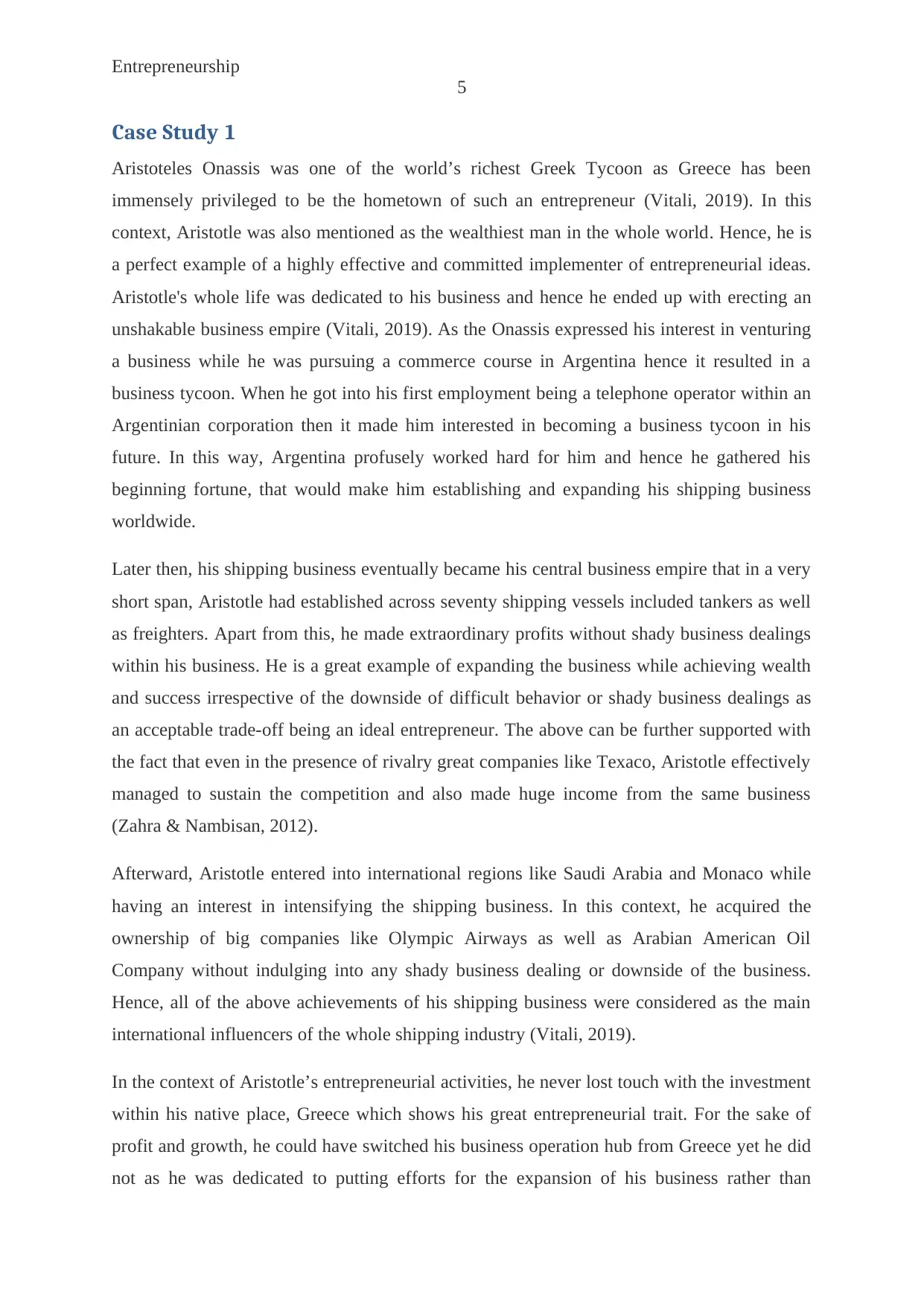
Entrepreneurship
5
Case Study 1
Aristoteles Onassis was one of the world’s richest Greek Tycoon as Greece has been
immensely privileged to be the hometown of such an entrepreneur (Vitali, 2019). In this
context, Aristotle was also mentioned as the wealthiest man in the whole world. Hence, he is
a perfect example of a highly effective and committed implementer of entrepreneurial ideas.
Aristotle's whole life was dedicated to his business and hence he ended up with erecting an
unshakable business empire (Vitali, 2019). As the Onassis expressed his interest in venturing
a business while he was pursuing a commerce course in Argentina hence it resulted in a
business tycoon. When he got into his first employment being a telephone operator within an
Argentinian corporation then it made him interested in becoming a business tycoon in his
future. In this way, Argentina profusely worked hard for him and hence he gathered his
beginning fortune, that would make him establishing and expanding his shipping business
worldwide.
Later then, his shipping business eventually became his central business empire that in a very
short span, Aristotle had established across seventy shipping vessels included tankers as well
as freighters. Apart from this, he made extraordinary profits without shady business dealings
within his business. He is a great example of expanding the business while achieving wealth
and success irrespective of the downside of difficult behavior or shady business dealings as
an acceptable trade-off being an ideal entrepreneur. The above can be further supported with
the fact that even in the presence of rivalry great companies like Texaco, Aristotle effectively
managed to sustain the competition and also made huge income from the same business
(Zahra & Nambisan, 2012).
Afterward, Aristotle entered into international regions like Saudi Arabia and Monaco while
having an interest in intensifying the shipping business. In this context, he acquired the
ownership of big companies like Olympic Airways as well as Arabian American Oil
Company without indulging into any shady business dealing or downside of the business.
Hence, all of the above achievements of his shipping business were considered as the main
international influencers of the whole shipping industry (Vitali, 2019).
In the context of Aristotle’s entrepreneurial activities, he never lost touch with the investment
within his native place, Greece which shows his great entrepreneurial trait. For the sake of
profit and growth, he could have switched his business operation hub from Greece yet he did
not as he was dedicated to putting efforts for the expansion of his business rather than
5
Case Study 1
Aristoteles Onassis was one of the world’s richest Greek Tycoon as Greece has been
immensely privileged to be the hometown of such an entrepreneur (Vitali, 2019). In this
context, Aristotle was also mentioned as the wealthiest man in the whole world. Hence, he is
a perfect example of a highly effective and committed implementer of entrepreneurial ideas.
Aristotle's whole life was dedicated to his business and hence he ended up with erecting an
unshakable business empire (Vitali, 2019). As the Onassis expressed his interest in venturing
a business while he was pursuing a commerce course in Argentina hence it resulted in a
business tycoon. When he got into his first employment being a telephone operator within an
Argentinian corporation then it made him interested in becoming a business tycoon in his
future. In this way, Argentina profusely worked hard for him and hence he gathered his
beginning fortune, that would make him establishing and expanding his shipping business
worldwide.
Later then, his shipping business eventually became his central business empire that in a very
short span, Aristotle had established across seventy shipping vessels included tankers as well
as freighters. Apart from this, he made extraordinary profits without shady business dealings
within his business. He is a great example of expanding the business while achieving wealth
and success irrespective of the downside of difficult behavior or shady business dealings as
an acceptable trade-off being an ideal entrepreneur. The above can be further supported with
the fact that even in the presence of rivalry great companies like Texaco, Aristotle effectively
managed to sustain the competition and also made huge income from the same business
(Zahra & Nambisan, 2012).
Afterward, Aristotle entered into international regions like Saudi Arabia and Monaco while
having an interest in intensifying the shipping business. In this context, he acquired the
ownership of big companies like Olympic Airways as well as Arabian American Oil
Company without indulging into any shady business dealing or downside of the business.
Hence, all of the above achievements of his shipping business were considered as the main
international influencers of the whole shipping industry (Vitali, 2019).
In the context of Aristotle’s entrepreneurial activities, he never lost touch with the investment
within his native place, Greece which shows his great entrepreneurial trait. For the sake of
profit and growth, he could have switched his business operation hub from Greece yet he did
not as he was dedicated to putting efforts for the expansion of his business rather than
⊘ This is a preview!⊘
Do you want full access?
Subscribe today to unlock all pages.

Trusted by 1+ million students worldwide
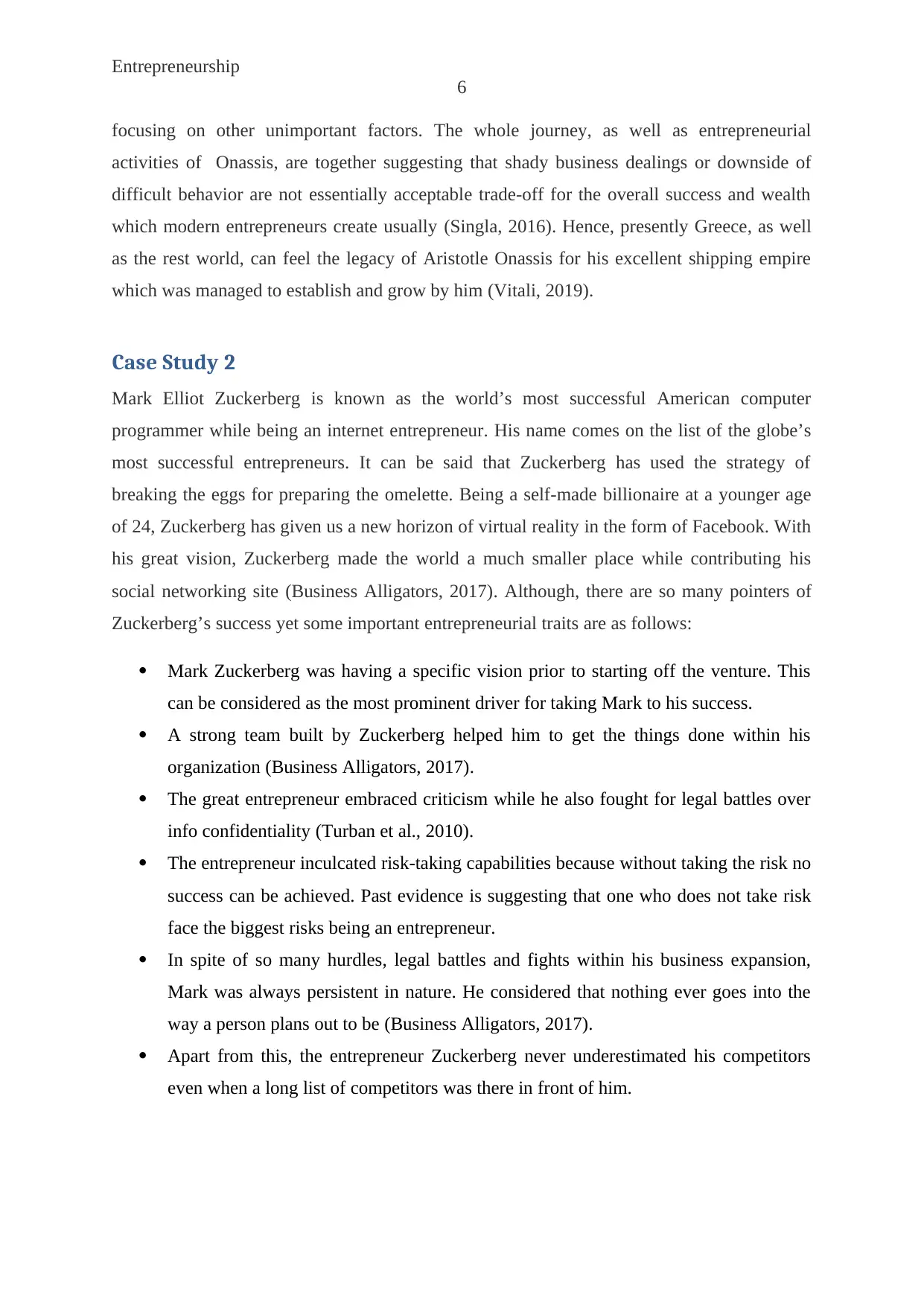
Entrepreneurship
6
focusing on other unimportant factors. The whole journey, as well as entrepreneurial
activities of Onassis, are together suggesting that shady business dealings or downside of
difficult behavior are not essentially acceptable trade-off for the overall success and wealth
which modern entrepreneurs create usually (Singla, 2016). Hence, presently Greece, as well
as the rest world, can feel the legacy of Aristotle Onassis for his excellent shipping empire
which was managed to establish and grow by him (Vitali, 2019).
Case Study 2
Mark Elliot Zuckerberg is known as the world’s most successful American computer
programmer while being an internet entrepreneur. His name comes on the list of the globe’s
most successful entrepreneurs. It can be said that Zuckerberg has used the strategy of
breaking the eggs for preparing the omelette. Being a self-made billionaire at a younger age
of 24, Zuckerberg has given us a new horizon of virtual reality in the form of Facebook. With
his great vision, Zuckerberg made the world a much smaller place while contributing his
social networking site (Business Alligators, 2017). Although, there are so many pointers of
Zuckerberg’s success yet some important entrepreneurial traits are as follows:
Mark Zuckerberg was having a specific vision prior to starting off the venture. This
can be considered as the most prominent driver for taking Mark to his success.
A strong team built by Zuckerberg helped him to get the things done within his
organization (Business Alligators, 2017).
The great entrepreneur embraced criticism while he also fought for legal battles over
info confidentiality (Turban et al., 2010).
The entrepreneur inculcated risk-taking capabilities because without taking the risk no
success can be achieved. Past evidence is suggesting that one who does not take risk
face the biggest risks being an entrepreneur.
In spite of so many hurdles, legal battles and fights within his business expansion,
Mark was always persistent in nature. He considered that nothing ever goes into the
way a person plans out to be (Business Alligators, 2017).
Apart from this, the entrepreneur Zuckerberg never underestimated his competitors
even when a long list of competitors was there in front of him.
6
focusing on other unimportant factors. The whole journey, as well as entrepreneurial
activities of Onassis, are together suggesting that shady business dealings or downside of
difficult behavior are not essentially acceptable trade-off for the overall success and wealth
which modern entrepreneurs create usually (Singla, 2016). Hence, presently Greece, as well
as the rest world, can feel the legacy of Aristotle Onassis for his excellent shipping empire
which was managed to establish and grow by him (Vitali, 2019).
Case Study 2
Mark Elliot Zuckerberg is known as the world’s most successful American computer
programmer while being an internet entrepreneur. His name comes on the list of the globe’s
most successful entrepreneurs. It can be said that Zuckerberg has used the strategy of
breaking the eggs for preparing the omelette. Being a self-made billionaire at a younger age
of 24, Zuckerberg has given us a new horizon of virtual reality in the form of Facebook. With
his great vision, Zuckerberg made the world a much smaller place while contributing his
social networking site (Business Alligators, 2017). Although, there are so many pointers of
Zuckerberg’s success yet some important entrepreneurial traits are as follows:
Mark Zuckerberg was having a specific vision prior to starting off the venture. This
can be considered as the most prominent driver for taking Mark to his success.
A strong team built by Zuckerberg helped him to get the things done within his
organization (Business Alligators, 2017).
The great entrepreneur embraced criticism while he also fought for legal battles over
info confidentiality (Turban et al., 2010).
The entrepreneur inculcated risk-taking capabilities because without taking the risk no
success can be achieved. Past evidence is suggesting that one who does not take risk
face the biggest risks being an entrepreneur.
In spite of so many hurdles, legal battles and fights within his business expansion,
Mark was always persistent in nature. He considered that nothing ever goes into the
way a person plans out to be (Business Alligators, 2017).
Apart from this, the entrepreneur Zuckerberg never underestimated his competitors
even when a long list of competitors was there in front of him.
Paraphrase This Document
Need a fresh take? Get an instant paraphrase of this document with our AI Paraphraser
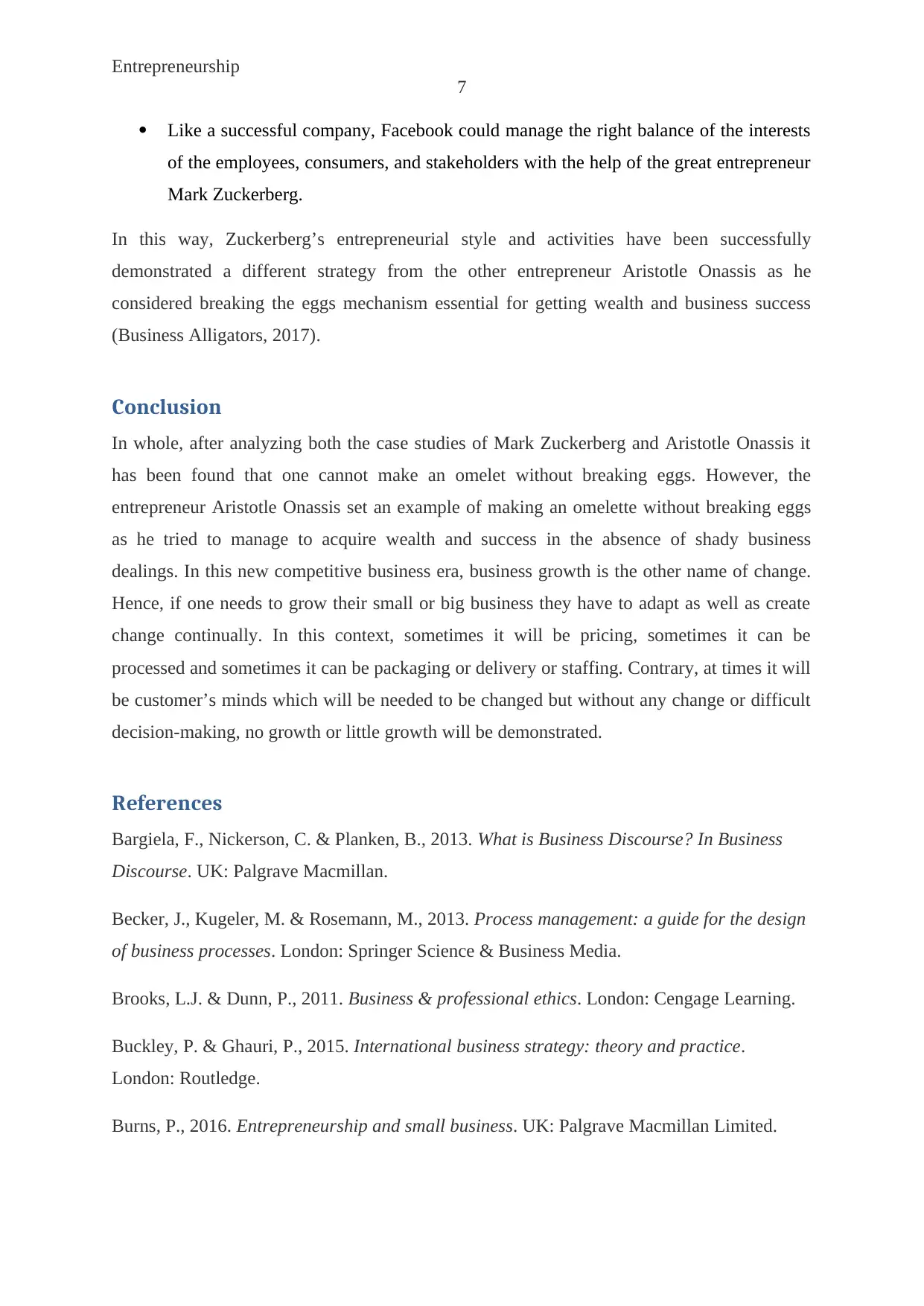
Entrepreneurship
7
Like a successful company, Facebook could manage the right balance of the interests
of the employees, consumers, and stakeholders with the help of the great entrepreneur
Mark Zuckerberg.
In this way, Zuckerberg’s entrepreneurial style and activities have been successfully
demonstrated a different strategy from the other entrepreneur Aristotle Onassis as he
considered breaking the eggs mechanism essential for getting wealth and business success
(Business Alligators, 2017).
Conclusion
In whole, after analyzing both the case studies of Mark Zuckerberg and Aristotle Onassis it
has been found that one cannot make an omelet without breaking eggs. However, the
entrepreneur Aristotle Onassis set an example of making an omelette without breaking eggs
as he tried to manage to acquire wealth and success in the absence of shady business
dealings. In this new competitive business era, business growth is the other name of change.
Hence, if one needs to grow their small or big business they have to adapt as well as create
change continually. In this context, sometimes it will be pricing, sometimes it can be
processed and sometimes it can be packaging or delivery or staffing. Contrary, at times it will
be customer’s minds which will be needed to be changed but without any change or difficult
decision-making, no growth or little growth will be demonstrated.
References
Bargiela, F., Nickerson, C. & Planken, B., 2013. What is Business Discourse? In Business
Discourse. UK: Palgrave Macmillan.
Becker, J., Kugeler, M. & Rosemann, M., 2013. Process management: a guide for the design
of business processes. London: Springer Science & Business Media.
Brooks, L.J. & Dunn, P., 2011. Business & professional ethics. London: Cengage Learning.
Buckley, P. & Ghauri, P., 2015. International business strategy: theory and practice.
London: Routledge.
Burns, P., 2016. Entrepreneurship and small business. UK: Palgrave Macmillan Limited.
7
Like a successful company, Facebook could manage the right balance of the interests
of the employees, consumers, and stakeholders with the help of the great entrepreneur
Mark Zuckerberg.
In this way, Zuckerberg’s entrepreneurial style and activities have been successfully
demonstrated a different strategy from the other entrepreneur Aristotle Onassis as he
considered breaking the eggs mechanism essential for getting wealth and business success
(Business Alligators, 2017).
Conclusion
In whole, after analyzing both the case studies of Mark Zuckerberg and Aristotle Onassis it
has been found that one cannot make an omelet without breaking eggs. However, the
entrepreneur Aristotle Onassis set an example of making an omelette without breaking eggs
as he tried to manage to acquire wealth and success in the absence of shady business
dealings. In this new competitive business era, business growth is the other name of change.
Hence, if one needs to grow their small or big business they have to adapt as well as create
change continually. In this context, sometimes it will be pricing, sometimes it can be
processed and sometimes it can be packaging or delivery or staffing. Contrary, at times it will
be customer’s minds which will be needed to be changed but without any change or difficult
decision-making, no growth or little growth will be demonstrated.
References
Bargiela, F., Nickerson, C. & Planken, B., 2013. What is Business Discourse? In Business
Discourse. UK: Palgrave Macmillan.
Becker, J., Kugeler, M. & Rosemann, M., 2013. Process management: a guide for the design
of business processes. London: Springer Science & Business Media.
Brooks, L.J. & Dunn, P., 2011. Business & professional ethics. London: Cengage Learning.
Buckley, P. & Ghauri, P., 2015. International business strategy: theory and practice.
London: Routledge.
Burns, P., 2016. Entrepreneurship and small business. UK: Palgrave Macmillan Limited.
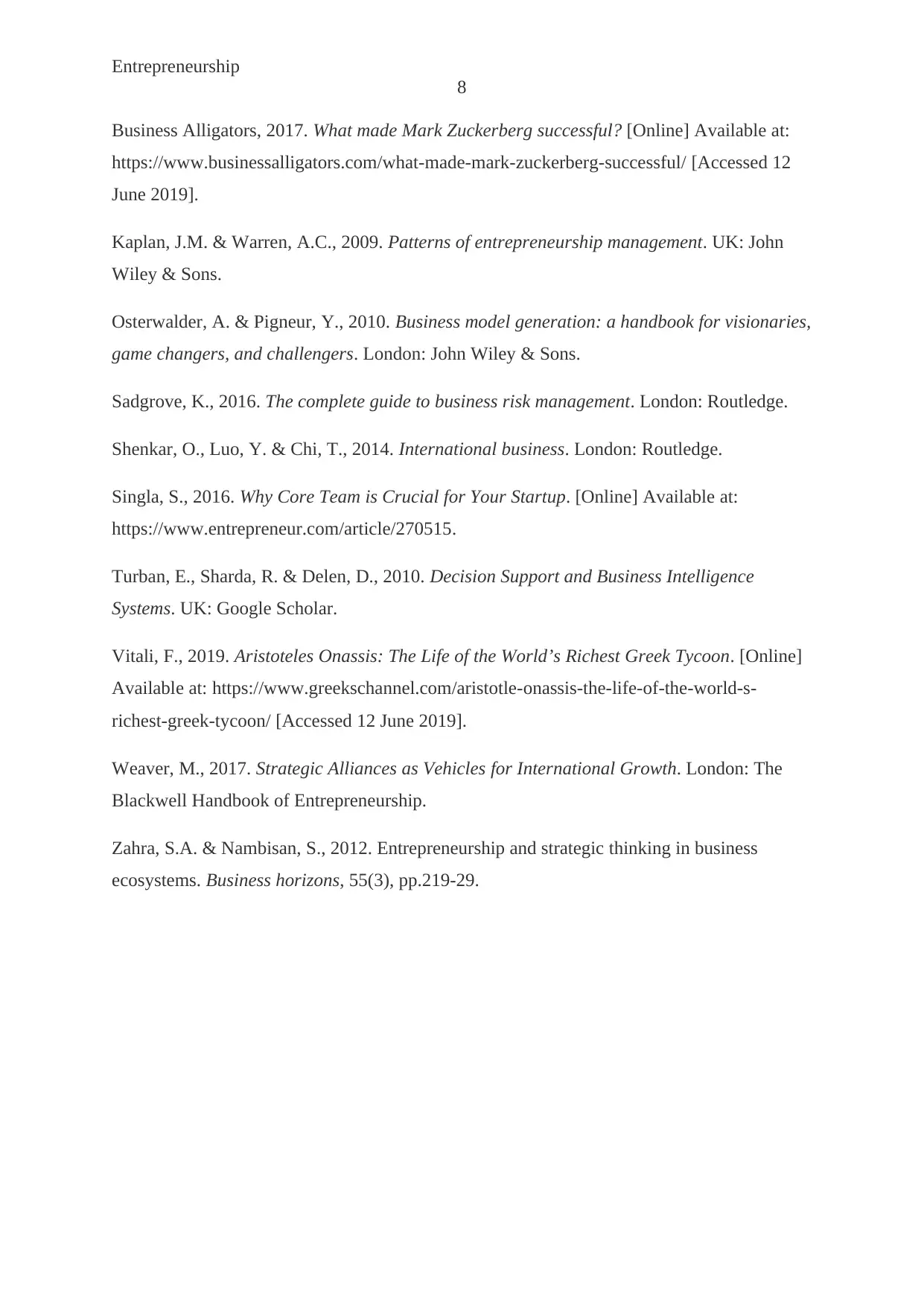
Entrepreneurship
8
Business Alligators, 2017. What made Mark Zuckerberg successful? [Online] Available at:
https://www.businessalligators.com/what-made-mark-zuckerberg-successful/ [Accessed 12
June 2019].
Kaplan, J.M. & Warren, A.C., 2009. Patterns of entrepreneurship management. UK: John
Wiley & Sons.
Osterwalder, A. & Pigneur, Y., 2010. Business model generation: a handbook for visionaries,
game changers, and challengers. London: John Wiley & Sons.
Sadgrove, K., 2016. The complete guide to business risk management. London: Routledge.
Shenkar, O., Luo, Y. & Chi, T., 2014. International business. London: Routledge.
Singla, S., 2016. Why Core Team is Crucial for Your Startup. [Online] Available at:
https://www.entrepreneur.com/article/270515.
Turban, E., Sharda, R. & Delen, D., 2010. Decision Support and Business Intelligence
Systems. UK: Google Scholar.
Vitali, F., 2019. Aristoteles Onassis: The Life of the World’s Richest Greek Tycoon. [Online]
Available at: https://www.greekschannel.com/aristotle-onassis-the-life-of-the-world-s-
richest-greek-tycoon/ [Accessed 12 June 2019].
Weaver, M., 2017. Strategic Alliances as Vehicles for International Growth. London: The
Blackwell Handbook of Entrepreneurship.
Zahra, S.A. & Nambisan, S., 2012. Entrepreneurship and strategic thinking in business
ecosystems. Business horizons, 55(3), pp.219-29.
8
Business Alligators, 2017. What made Mark Zuckerberg successful? [Online] Available at:
https://www.businessalligators.com/what-made-mark-zuckerberg-successful/ [Accessed 12
June 2019].
Kaplan, J.M. & Warren, A.C., 2009. Patterns of entrepreneurship management. UK: John
Wiley & Sons.
Osterwalder, A. & Pigneur, Y., 2010. Business model generation: a handbook for visionaries,
game changers, and challengers. London: John Wiley & Sons.
Sadgrove, K., 2016. The complete guide to business risk management. London: Routledge.
Shenkar, O., Luo, Y. & Chi, T., 2014. International business. London: Routledge.
Singla, S., 2016. Why Core Team is Crucial for Your Startup. [Online] Available at:
https://www.entrepreneur.com/article/270515.
Turban, E., Sharda, R. & Delen, D., 2010. Decision Support and Business Intelligence
Systems. UK: Google Scholar.
Vitali, F., 2019. Aristoteles Onassis: The Life of the World’s Richest Greek Tycoon. [Online]
Available at: https://www.greekschannel.com/aristotle-onassis-the-life-of-the-world-s-
richest-greek-tycoon/ [Accessed 12 June 2019].
Weaver, M., 2017. Strategic Alliances as Vehicles for International Growth. London: The
Blackwell Handbook of Entrepreneurship.
Zahra, S.A. & Nambisan, S., 2012. Entrepreneurship and strategic thinking in business
ecosystems. Business horizons, 55(3), pp.219-29.
⊘ This is a preview!⊘
Do you want full access?
Subscribe today to unlock all pages.

Trusted by 1+ million students worldwide
1 out of 9
Related Documents
Your All-in-One AI-Powered Toolkit for Academic Success.
+13062052269
info@desklib.com
Available 24*7 on WhatsApp / Email
![[object Object]](/_next/static/media/star-bottom.7253800d.svg)
Unlock your academic potential
Copyright © 2020–2025 A2Z Services. All Rights Reserved. Developed and managed by ZUCOL.




